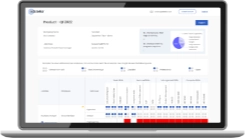
Every Chief Operating Officer operates in the tension between strategy and execution. Each day is a mix of urgent demands and long-term priorities across shifting markets, global supply chains, and operational pressures. In this complexity, clarity isn't optional; it's survival.
That clarity comes from numbers that tell the truth. The right KPIs don't just measure activity; they expose whether the organization is actually progressing.
The point is simple: measurement precedes management. For a modern COO, metrics aren't dashboards; they're direction.
When KPIs are well chosen, they turn complexity into insight, revealing patterns, bottlenecks, and risks before they escalate. Yet many organizations fail here. They measure plenty but align little, producing reports that inform but rarely influence decisions.
For COOs, that misalignment erodes operational discipline. Teams become reactive, resources drift, and priorities blur. The real challenge isn't tracking more metrics, it's tracking the right ones.
This article breaks down 16 essential KPIs across Financial Performance, Working Capital Management, Operational Efficiency, Quality & Compliance, and Workforce Management. Together, they offer a clear framework for making confident, data-driven operational decisions.
KPIs aren't just numbers. They are the pulse of execution and the indicator of whether your organization is driving change or being driven by it.
16 Critical KPIs Every COO Must Track
These 16 metrics provide a holistic framework, enabling executives to optimize resources, mitigate risks, and capitalize on growth opportunities. Backed by studies from leading consultancies, they offer actionable insights tailored to leadership in high-stakes environments.
Financial Performance Metrics
The COO’s lens must extend beyond operations into the financial pulse of the enterprise. Understanding how operational decisions impact profitability, efficiency, and shareholder value is essential. Financial KPIs help leaders evaluate whether the organization’s operating model is sustainable, scalable, and aligned with strategic growth.
1. Gross Profit Margin
This metric represents how efficiently a company produces and sells its goods or services before considering overheads and taxes. For COOs, it reflects the health of the core operation, whether production, logistics, and procurement are optimized to support profitability.
- A consistently declining margin can signal rising input costs, supply chain inefficiencies, or pricing misalignment. A 2024 study on operational efficiency found that KPIs linked to cost management and productivity directly enhance competitive advantage. For COOs, the gross margin acts as a financial compass, indicating how effectively operational activities translate into profit.
- A high margin often indicates strong supplier management, process automation, and product-market fit. A falling margin demands a root-cause analysis: Are procurement costs rising? Is the production cycle inefficient? Or is the pricing strategy eroding profitability?
2. Net Profit Margin
While CFOs traditionally track profitability, COOs have direct influence over it through operational design, process optimization, and workforce efficiency. Every operational decision from vendor selection to process improvement affects the bottom line.
- A healthy net margin signals an efficient cost structure and disciplined operations. For COOs, it validates whether operational strategies truly drive financial value.
- Improving net margin requires collaboration across departments: reducing waste, renegotiating contracts, automating manual workflows, and continuously improving process efficiency. Margins often reveal the effectiveness of the COO’s cross-functional influence.
3. Return on Equity (ROE)
Though often viewed as a CFO metric, ROE reflects how effectively operations contribute to shareholder value. Operational efficiency, cost control, and asset utilization, all within the COO’s remit, play key roles in shaping ROE.
- High ROE indicates that operational and financial strategies are aligned. Low ROE may point to underutilized assets or inefficient capital allocation. As the Operations Council notes, the COO’s partnership with finance ensures that process improvements translate into tangible value creation.
- If profitability remains constant but ROE declines, it may indicate excess capital investment or poor working capital management, both areas under operational influence.
4. Return on Assets (ROA)
ROA captures how efficiently an organization uses its total resources, from machinery to intellectual property, to generate profit. It’s a true measure of operational effectiveness and capital stewardship.
- A declining ROA suggests that the organization’s investment in assets isn’t producing proportional returns. For COOs, it prompts a deeper review into whether assets are underused or processes require modernization.
5. Operating Expense Ratio
This KPI measures what portion of revenue is consumed by day-to-day operations, salaries, utilities, administration, and technology. For a COO, it reflects the efficiency of the organization’s cost structure.
- The lower the ratio, the more scalable and efficient the operating model. A 2024 ResearchGate study on KPI impact confirmed that companies maintaining low operating expense ratios outperform peers in operational efficiency and profitability.
- A sudden rise in this ratio often signals inefficiencies or overstaffing. COOs should analyze cost trends by function and region, evaluate automation opportunities, and review vendor contracts for optimization. Maintaining an efficient expense ratio allows reinvestment into innovation, talent, and growth pillars of sustainable success.
Working Capital Management
Strong working capital management is a hallmark of operational excellence. For COOs, it’s not just a finance concern; it’s a real-time operational metric that reveals how effectively cash flows through the business. Balancing receivables, payables, and inventory determines whether the organization runs lean or gets trapped in liquidity pressure.
6. Days Sales Outstanding
Accounts receivable represent the outstanding payments owed to a company by its clients or customers. This metric is often expressed in Days Sales Outstanding (DSO) the average number of days it takes to collect payment after a sale.
- Cash flow is the lifeblood of operations. A growing receivables balance means revenue is being booked faster than cash is collected, a risk for any COO overseeing procurement, production, or staffing that relies on predictable cash inflow.
- High DSO can be a signal of misaligned credit terms, billing inefficiencies, or customer dissatisfaction.
- Monitor DSO trends over time rather than focusing on one-off figures. An increase might indicate that credit policies are too generous or that invoice accuracy is declining. Best-performing COOs collaborate with finance to tighten payment terms, automate billing, and improve collection discipline all while maintaining customer relationships.
7. Days Payables Outstanding (DPO)
Accounts payable represent the money a company owes suppliers for goods or services received. It is often measured through Days Payables Outstanding (DPO) the average number of days taken to pay suppliers.
- Payables management is a balancing act. Extending DPO too far can strain supplier relationships, while paying too early can limit cash available for operations or investments. A COO’s task is to optimize not minimize payment cycles.
- When DPO is increasing, ensure it’s due to strategic cash management rather than delayed processing or strained vendor trust. When it’s falling, assess if the company is missing opportunities to hold cash longer or negotiate better payment terms. Effective COOs use DPO as a pulse check on both financial flexibility and supplier confidence.
Operational Efficiency
If financial performance measures how well an organization turns operations into profit, operational efficiency determines how intelligently it executes. For a COO, this category reveals the health of processes, the smoothness of supply chains, the speed of delivery, and the balance between capacity and demand.
8. Inventory Turnover
This metric quantifies how many times inventory is sold and replaced within a period. It shows how effectively the company balances supply with demand.
- High inventory turnover signals efficient stock management and strong sales velocity, while low turnover points to overproduction, weak demand forecasting, or process bottlenecks. For COOs, inventory efficiency directly impacts working capital and profitability.
- A declining turnover ratio means stock is sitting longer than expected. COOs should investigate whether sales forecasts are inaccurate, product demand has shifted, or the procurement cycle is too rigid. In contrast, too high a turnover might cause missed sales opportunities due to understocking an equally dangerous outcome.
9. Supply Chain Efficiency
Supply chain efficiency measures the organization’s ability to deliver products and services to customers at minimal cost, optimal speed, and consistent quality. It often integrates sub-metrics such as lead time, order fulfillment rate, logistics cost per unit, and supplier reliability.
- Modern supply chains are complex, global, and fragile. A single disruption a delayed shipment, an unresponsive vendor, or a compliance breach can ripple through the organization. A COO’s ability to design resilient and efficient supply networks can make or break profitability.
- COOs should track not only costs but also cycle time and reliability the percentage of orders delivered complete and on schedule. Benchmarking supplier performance, diversifying vendor bases, and integrating AI-driven forecasting systems are among the best practices. In times of disruption, such as global logistics slowdowns, companies with agile supply chain KPIs recover faster and maintain customer confidence.
10. On-Time Delivery Rate
- This KPI captures an organization’s ability to fulfill customer expectations precisely as promised. In many industries, it is the ultimate indicator of operational reliability. Delays damage credibility, increase costs, and erode customer trust. For a COO, on-time delivery is not a logistics metric; it’s a customer satisfaction metric disguised as an operational one. Each delay exposes a weak link in the operational chain, from planning to execution.
- If on-time delivery is trending downward, COOs must investigate lead time variability, supplier reliability, or scheduling inefficiencies. Cross-functional coordination of production, logistics, and sales is key. The best organizations don’t just measure timeliness; they integrate predictive analytics to anticipate delivery risks before they happen.
Quality & Compliance
Operational success means little without quality and compliance. For a COO, these metrics safeguard reputation, maintain customer trust, and ensure the organization operates ethically and sustainably. Beyond compliance with laws or standards, these KPIs reflect a company’s internal discipline the invisible framework that protects brand integrity and long-term viability.
11. Quality Control Index
A composite indicator capturing defect rates, rework percentages, and customer returns. It may also include the “Defects Per Million Opportunities (DPMO)” metric used in Six Sigma frameworks.
- Quality is the mirror of operational excellence. It defines how consistently processes deliver outcomes that meet or exceed expectations. A study published on ResearchGate highlights that quality-related KPIs are among the strongest predictors of long-term organizational effectiveness.
- For a COO, poor quality scores are not merely technical failures; they are strategic warnings. They suggest breakdowns in process discipline, communication, or training. Every quality deviation consumes time, damages credibility, and adds hidden costs.
- A rising defect or rework rate should trigger a cross-functional root cause analysis. Is it due to supplier inconsistency, employee training gaps, or outdated equipment? Progressive COOs embed continuous improvement philosophies (Lean, Six Sigma, Kaizen) across teams, ensuring that quality isn’t a department, it’s a culture.
12. Environmental Sustainability Metrics
this is a composite KPI multiple formulas depending on the metric.
KPIs that assess environmental impact, such as energy consumption per unit of output, waste recycling rate, CO₂ emissions, or supplier sustainability scorecards.
- Sustainability is no longer a corporate virtue; it’s a strategic imperative. Customers, investors, and regulators all expect measurable environmental responsibility. A 2024 IJRPR study revealed that organizations integrating sustainability metrics into performance reviews achieve stronger stakeholder trust and operational cost reductions.
- For COOs, this is about operational optimization as much as ethics. Energy-efficient production, reduced waste, and smarter logistics often lead to lower costs and improved resilience.
- Track sustainability metrics alongside financial ones, energy efficiency projects can boost margins while meeting compliance goals. When measured correctly, sustainability indicators double as cost-management tools. For instance, reduced fuel use in logistics cuts both emissions and expenses, aligning ESG targets with operational efficiency
Workforce Management
The COO’s responsibility doesn’t stop at systems and processes it extends to people. A company’s ability to execute strategy depends on its workforce’s capability, engagement, and safety. Workforce KPIs reveal whether teams are empowered, productive, and aligned with the organization’s goals.
13. Employee Productivity
Employee Productivity measures output per employee, often calculated as revenue per employee or value added per labor hour.
- Productivity is the direct bridge between human potential and business outcomes. A systematic review on employee productivity found that motivation, training, and workplace environment strongly correlate with output quality and efficiency.
- For COOs, productivity is not about pushing people harder; it’s about designing smarter workflows, eliminating waste, and ensuring that employees spend time on high-value tasks. When productivity dips, it often signals unclear priorities, inefficient systems, or inadequate tools.
- Track productivity trends against contextual data: workload, employee satisfaction, and technology usage. A rise in productivity following automation or training programs is a signal that investments are paying off. Conversely, sudden drops could point to burnout or process misalignment.
- Leadership actions like cross-functional collaboration and transparent communication often have the strongest long-term impact on productivity more than any system or process tweak.
14. Employee Training Costs
Total training expenditure divided by the number of employees trained or as a percentage of payroll.
- Training is not an expense, it’s an investment in capability. A workforce’s ability to adapt, learn, and innovate defines whether an organization thrives in disruption or falters. As studies in organizational learning show, companies that invest consistently in employee development report higher productivity, lower turnover, and better customer satisfaction.
- For COOs, understanding training costs connects operational strategy to human capital. Every process improvement, every technology upgrade, and every quality initiative depends on people being properly equipped.
- Training ROI should be tracked against performance metrics, such as fewer errors, faster project delivery, and higher employee engagement. If training costs rise but productivity does not, review the content, delivery, and timing. Effective COOs ensure that training aligns directly with strategic initiatives, not generic skill-building.
15. Absenteeism Rate
- Absenteeism is often the first symptom of deeper organizational issues, such as burnout, disengagement, health challenges, or poor leadership communication. A 2022 study published on PMC showed that workplace environment and leadership support significantly influence attendance and commitment.
- For COOs, absenteeism is more than an HR statistic; it’s an operational reliability metric. It affects capacity planning, delivery schedules, and service consistency.
- Monitor absenteeism trends by department or geography. Rising absenteeism may point to cultural or process stress points. Address root causes through workload balancing, employee well-being programs, and open dialogue. High-performing COOs view employee presence as a measure of engagement, not compliance.
16. Safety Incident Rate
Safety metrics embody a company’s respect for its workforce. Every incident avoided protects productivity, reputation, and, most importantly lives. Beyond legal compliance, safety is a cultural indicator: do people feel protected, valued, and empowered to speak up?
- Industries with rigorous safety programs, such as manufacturing and energy, have shown that a strong safety culture correlates with higher operational performance. A COO who leads safety initiatives not only minimizes risk but also fosters trust and accountability.
- If incident rates rise, the focus should move beyond reporting toward prevention: improved equipment, safety training, and root-cause analysis. The goal is not zero incidents on paper, it’s genuine zero harm in practice.
Conclusion
The true strength of a COO lies not in managing every process, but in knowing which levers move the business forward. Key Performance Indicators are the instruments that turn strategy into visibility, and visibility into action.
Each of the sixteen KPIs discussed, from profit margins to employee productivity, tells a fragment of the operational story. Together, they reveal whether the organization is agile, disciplined, and aligned with its mission. They expose inefficiencies early, highlight opportunities for growth, and ensure that performance decisions are grounded in evidence rather than intuition.
But KPIs are not just numbers; they are conversations about progress. A skilled COO interprets them with context, curiosity, and purpose. They look beyond the charts and ratios to understand what drives those results: people, processes, systems, or culture, and act on that understanding with precision.
High-performing organizations share a common rhythm: they measure what matters, act with intent, and learn continuously. This rhythm is led by COOs who view KPIs not as constraints, but as compasses guiding their teams toward operational excellence.
In the end, the mark of great operational leadership isn’t the volume of data reviewed, it’s the clarity it creates. The best COOs turn measurement into momentum, ensuring that every decision, every process, and every person contributes to a shared vision of sustainable performance.
Because what truly defines operational mastery isn’t just managing operations efficiently, it’s managing them intelligently. For organizations focused on employee upskilling, resources like Edstellar’s Skills Matrix offer a structured approach to identifying and addressing competency gaps. Additionally, exploring Edstellar’s catalog of over 2000 courses can provide targeted training solutions to support workforce development initiatives.
Frequently Asked Questions
Explore High-impact instructor-led training for your teams.
#On-site #Virtual #GroupTraining #Customized

Bridge the Gap Between Learning & Performance
Turn Your Training Programs Into Revenue Drivers.
Schedule a ConsultationEdstellar Training Catalog
Explore 2000+ industry ready instructor-led training programs.

Coaching that Unlocks Potential
Create dynamic leaders and cohesive teams. Learn more now!


Want to evaluate your team’s skill gaps?
Do a quick Skill gap analysis with Edstellar’s Free Skill Matrix tool

Transform Your L&D Strategy Today
Unlock premium resources, tools, and frameworks designed for HR and learning professionals. Our L&D Hub gives you everything needed to elevate your organization's training approach.
Access L&D Hub Resources.svg)
.svg)



.svg)


.svg)
.svg)
.svg)
.svg)

